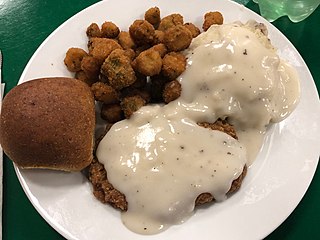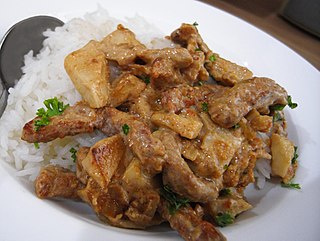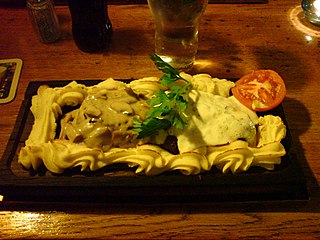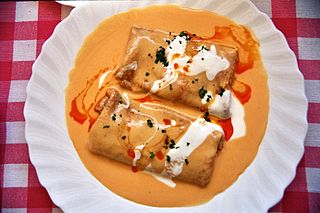
Chicken-fried steak, also known as country-fried steak or CFS, is an American breaded cutlet dish consisting of a piece of beefsteak coated with seasoned flour and either deep-fried or pan-fried. It is sometimes associated with the Southern cuisine of the United States. It is breaded and fried with a technique similar to the more common fried chicken, hence "chicken-fried". When deep-fried, it is usually referred to as "chicken-fried steak". Pan-fried versions are typically referred to as "country fried steak".

Steak and kidney pie is a popular British dish. It is a savoury pie filled principally with a mixture of diced beef, diced kidney and onion. Its contents are generally similar to those of steak and kidney puddings.

Beef Stroganoff or Beef Stroganov is a Russian dish of sautéed pieces of beef in a sauce of mustard and smetana. From its origins in mid-19th-century Russia, it has become popular around the world, with considerable variation from the original recipe. Mushrooms are common in many variants.

A schnitzel is a thin slice of meat. The meat is usually thinned by pounding with a meat tenderizer. Most commonly, the meat is breaded before frying. Breaded schnitzel is popular in many countries and is made using veal, pork, chicken, mutton, beef, or turkey. Schnitzel is very similar to the dish escalope in France and Spain, panado in Portugal, tonkatsu in Japan, cotoletta in Italy, kotlet schabowy in Poland, milanesa in Latin America, chuleta valluna in Colombia, and chicken-fried steak and pork tenderloin of the United States.

The Wallenberg family is a prominent Swedish family, Europe's most powerful business dynasty. Wallenbergs are noted as bankers, industrialists, politicians, bureaucrats, diplomats, and military officials. The Wallenberg sphere's holdings employ about 1 million people, and have sales of $154 billion a year. The Wallenberg empire consists of 16 Wallenberg Foundations, Foundation Asset Management AB (FAM), Investor AB, Patricia Industries, and Wallenberg Investments AB.

Parmigiana, also called parmigiana di melanzane[parmiˈdʒaːna di melanˈdzaːne; -ˈtsaːne], melanzane alla parmigiana[melanˈdzaːne; -ˈtsaːne ˌalla parmiˈdʒaːna], or eggplant parmesan, is an Italian dish made with fried, sliced eggplant layered with cheese and tomato sauce, then baked. The origin of the dish is claimed by the Southern regions of Calabria, Campania, Apulia and Sicily. Other variations found outside Italy may include chicken, veal, or another type of meat cutlet or vegetable filling.

Shish kofta (Turkish) is a type of kebab-style kofta dish in Turkish cuisine.

The Hungarian mixed grill or Fatányéros is a traditional Hungarian mixed meat barbecue dish, originating from Transylvania.

Hortobágyi palacsinta is a savoury Hungarian crêpe dish, filled with meat. The meat is prepared as a stew with onions and spices—similar to pörkölt or chicken paprikash—using veal, veal with mushrooms, chicken or Hungarian sausage. The crêpes are filled with the stew, tucking in the ends, and are baked in the oven with a paprika and tejföl sauce, then topped with fresh parsley. A popular serving option in Hungary to roll up the filled crêpes, or fold them into half and then rolling them up on the shorter side. The rolled up crêpes then can be stacked on each other with the sauce poured over them.

Chicken parmesan, or chicken parmigiana, is a dish that consists of breaded chicken breast covered in tomato sauce and mozzarella, parmesan, or provolone cheese. A quantity of ham or bacon is sometimes added.

Chicken Française Also known as "Wedding Chicken", is an Italian-American dish of flour-dredged, egg-dipped, sautéed chicken cutlets with a lemon-butter and white wine sauce. The dish is popular in the region surrounding Rochester, New York, where it is known as Chicken French, to the point that some have suggested the dish be called Chicken Rochester. When Italian immigrants arrived in Rochester, they brought their recipes with them, including veal francese, but they substituted chicken for the more expensive veal. Another source says that Veal Francese had been popular in the region since the 1950s, but when consumers boycotted veal in the 1970s, area chefs like James Cianciola of the Brown Derby Restaurant successfully substituted chicken. Cianciola credits chefs Tony Mammano and Joe Cairo with bringing the dish from New York City.

Vitello tonnato is a Piedmontese dish of cold, sliced veal covered with a creamy, mayonnaise-like sauce that has been flavored with tuna. It is served chilled or at room temperature, generally in the summertime, as the main course of an Italian meal or as "an exceedingly elegant antipasto for an elaborate dinner." It is also very popular, by inheritance, in Argentina, Uruguay and Paraguay, where it is known by its original name in Piedmontese dialect Vitel tonnè, and considered a traditional Christmas dish.

Veal liver and bacon is a dish containing veal liver and bacon.

Wiener schnitzel, sometimes spelled Wienerschnitzel, is a type of schnitzel made of a thin, breaded, pan-fried veal cutlet.
Cuisine of the Ionian islands or Heptanesean cuisine in Greece is the cuisine of the Ionian Islands region. It has more influences from Italian cuisine than can be found in any other part of Greece due to the long period of Venetian rule in the Ionian Islands.
Events from the year 1990 in Sweden

Jacob "Juju" Wallenberg was a Swedish banker and industrial leader. Wallenberg held various central positions in Stockholms Enskilda Bank. He was also chairman of the board of several companies, including Stora Kopparbergs Bergslag and Orkla Mining Company. From 1934 to 1944 he was a member of the Swedish governmental commission for trade with Germany.















